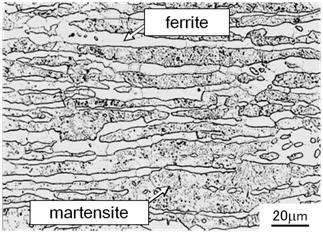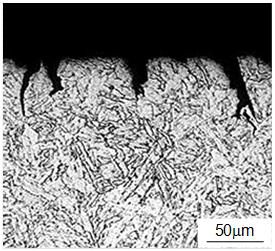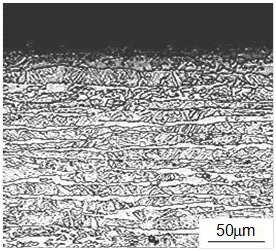Sumitomo Metals Developed High Strength and High Corrosion Resistant Alloy, Super 17Cr OCTG for Ultra Deep Well Application
December 7, 2011
- Sumitomo Metal Industries, Ltd.
Sumitomo Metal Industries, Ltd. (Sumitomo Metals) has developed a new martensitic stainless steel oil country tubular goods (OCTG)*1, SM17CRS-125 (referred to as "Super 17Cr "). Super 17Cr has the best-in-class corrosion resistance and strength in martensitic stainless steel OCTG. This product will be used to meet the increasing demand in ultra deep well developments and contribute to maintain the world's energy supply.
1. Background of Development
For developing oil and gas wells, seamless OCTG are generally used because of their higher reliability. 13Cr martensitic stainless steel*2 OCTG has been specifically used for applications containing carbon dioxide (CO2), because of its CO2 corrosion*3 resistance.
In recent years, developments of deep wells over 6,000 meters have been increasing. As a consequence material requirements have become more stringent: Higher Yield strength to withstand increasing formation pressure and string weight as well as corrosion resistance up to 200℃. In such environment, 13Cr OCTG cannot be used because of stress corrosion cracking (SCC)*4 limitation, and higher grades duplex stainless steel OCTG*5 have been used instead.
Duplex stainless steel OCTG, due to 22-25% Chromium content, has a better CO2 corrosion resistance and can be used up to 200℃. However, its cost is driven up by the significant amount of noble alloying elements such as nickel and molybdenum and its cold working process required to obtain its mechanical properties*6.
To respond to the growing demand for superior corrosion resistant OCTG for ultra deep well development, Sumitomo Metals has developed Super 17Cr steel which has better corrosion resistance than 13Cr with leaner alloy content than duplex stainless steels without cold working.
2. Characteristics of Super 17Cr
(1) Corrosion resistance for ultra deep gas wells containing CO2
Generally, larger content of chromium is required to prevent SCC in a high temperature and CO2 environment. Sumitomo Metals has found that 17% chromium is optimal to ensure corrosion resistance required for ultra deep CO2 containing wells.
(2) Strength required for ultra-deep wells
Fig 1: Microstructure of Super 17Cr Steel
 |
With 17% chromium, the material structure cannot be single phase of hard martensite, but dual phase containing some soft ferrite (refer to Fig 1). However, by optimizing other alloying elements, Sumitomo Metals succeeded to achieve 125ksi (861MPa) grade, which exceeds the general yield strength level of 13Cr; 80ksi-110ksi*7 (551-758MPa) grade without cold working process.
(3) Product performance
Fig 2 shows the corrosion test results under high temperature of Super 17Cr steel. Super 17Cr shows excellent corrosion resistance while Super 13Cr steel suffered stress corrosion cracking as well as higher corrosion rate.
Fig 2: SCC Test Results of Super 13Cr Steel and Super 17Cr Steel in 200℃ Environment
| Super 13 Cr steel | Super 17 Cr steel | |
 |
 |
|
| CO2 corrosion rate (1mm/y) SCC: Occurred |
CO2 corrosion rate (0.02mm/y) SCC: Did not occur |
Publication of Super 17Cr steel was released at the ISO Committee concerning corrosion resistant materials for OCTG and at the SPE workshop this September. Super 17Cr attracted the attention of major oil companies, and Sumitomo Metals has started providing samples for customer qualification.
3. Future outlook
Development of ultra deep wells is expected to increase, while easy applications / easy oil have already been tapped. Highly corrosive applications of choice for Super 17Cr are located deepwater offshore Brazil and Gulf of Mexico, ultra deep wells in South East Asia, Indian Ocean and west Australia, among others.
Considering the increasing world energy demand, Sumitomo Metals will continue to contribute to the highly complex oil and gas developments, by providing a wide, unique and innovative product line to meet customer demand.
<Terms>
*1 Martensitic stainless OCTG
They are made of stainless steel alloy, mainly composed of high-strength martensitic structure. In this material category, 13Cr steel and Super 13Cr steel are widely used. Martensite is a variety of steel micro structure formed by rapid cooling of austenite which is the general form of steel micro structure at high temperature. It typically features high strength and high toughness.
*2 13Cr OCTG
It contains 13% chromium and features superior corrosion resistance in C02 environment. With chromium content of 13% and above, the protective film on the steel surface becomes more stable and greatly enhances corrosion resistance.
*3 CO2 corrosion
Corrosion caused by crude oil or natural gas that contains CO2. CO2 corrosion is generally suppressed by increasing chromium content in the steel.
*4 Stress corrosion cracking (SCC)
Stress corrosion cracking may occur when a material is subjected to tensile stress in a corrosive environment, especially at elevated temperature. In the case of OCTG, material's application temperature limit is generally defined as the temperature above which SCC may start.
*5 Duplex stainless steel OCTG
Duplex stainless steel has dual phase microstructure consisting of ferrite and austenite. Compared to 13Cr Martensitic steel, Duplex stainless steel has a superior corrosion resistance due to its chromium, molybdenum and nickel content. With higher alloy content, rapid cooling may not transform the austenite (like austenite phase in duplex stainless steel). Ferrite possesses the same type but less irregular crystal, hence generally softer than martensite.
*6 Cold working is required to obtain high strength
Both the ferrite and austenite structures that constitute duplex stainless steel are soft metallic structures and cannot be hardened by heat treatment. Hence the material is generally finished by work hardening process – so called ‘cold working’ or ‘cold drawing’ process at ambient temperature.
*7 ksi
It is an abbreviation for ‘kilo pound per square inch’ a unit for material strength. For example, 80 ksi means that the material can withstand a force of 80,000 pounds (approx. 39,000 kg) applied to a section area of one square inch. 1 ksi = approximately 6.89 MPa/mm.
